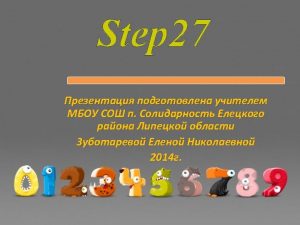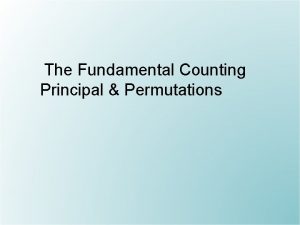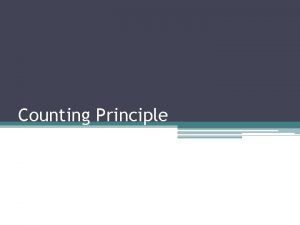Fundamental Counting Principal Good Morning happy Tuesday Counting
















- Slides: 16

Fundamental Counting Principal Good Morning happy Tuesday!

Counting Outcomes and Tree Diagrams Tree diagrams are used to help visualize and count outcomes. Example Tossing a coin 3 times

Tree Diagrams expanded Tree diagrams can be used to organize information and count outcomes Any path from left to right through the tree diagram is an outcome

Tree Diagrams Applied Root when actions are sequential of the tree corresponds to the starting point Branches connect the root to nodes representing different outcomes Process continues until all stages are complete

Example A fast food restaurant sells hot dogs, hamburgers, chicken sandwiches, and barbecue sandwiches. They offer as sides french fries, hushpuppies, or onion rings. How many possible combinations are there? Create a tree diagram to show this.

You try! A mechanic offers three types oil changes (standard, synthetic, and high mileage), two types of wiper blades (low profile, and heavy use) and two types of mufflers (chrome and matte black). What are the possible combinations? Make a Tree Diagram to show possible outcomes.

Fundamental Counting Principle Suppose that two events occur in order The first can occur in m ways The second can occur in n ways Then ways the two events can occur in m x n

Example An ice cream store offers three types of cones and 31 flavors. How many different singlecone ice-cream cones is it possible to buy at this store? Types of cones? 3 Flavors 31 of ice cream?

Solution 3 types of cones 31 By flavors of ice cream the Fundamental Counting Principle, there are 3 x 31 = 93 ways of choosing a single-scoop icecream cone at this store

Example In a certain state, automobile license plates display three letters followed by three digits. How many such plates are possible if repetition of the letter is allowed? How many choices for each letter? 26 How 10 many choices for each digit?

Solution 26 26 26 10 10 By 10 the Fundamental Counting Principle, the number of possible license plates is… 26 x 10 x 10 17, 576, 000

Example In a certain state, automobile license plates display three letters followed by three digits. How many such plates are possible if repetition of the letters is not allowed? How many choices for the first letter? 26 How many choices for the second letter? 25 How 24 many choices for the third letter?

Solution 26 25 24 10 10 By 10 the Fundamental Counting Principle, the number of possible license plates is… 26 x 25 x 24 x 10 15, 600, 000

Factorial Notation Product of the first n natural numbers Denoted by n! and is called n factorial n! = n x (n – 1) x (n – 2) x … x 1 8! = 8 x 7 x 6 x 5 x 4 x 3 x 2 x 1 0! = 1

Example In how many different ways can a race with six runners be completed? Assume there is no tie.

Solution Six possible choices for first place Five possible choices for second place Four choices for third place and so on… So, by the Fundamental Counting Principle the number of different ways the race can be completed is… 6 x 5 x 4 x 3 x 2 x 1 = 6! = 720
 Good evening students
Good evening students Good morning class!
Good morning class! Good afternoon teacher my name is
Good afternoon teacher my name is Good day class
Good day class In the morning glad i see
In the morning glad i see Stay home stay safe good morning images
Stay home stay safe good morning images Happy he
Happy he Good afternoon tom
Good afternoon tom Cómo se dice buenas tardes
Cómo se dice buenas tardes Good morning happy november
Good morning happy november Happy december good morning
Happy december good morning Good morning happy february
Good morning happy february Responses hello
Responses hello Tuesday morning prayer
Tuesday morning prayer Tuesday morning prayers
Tuesday morning prayers Tuesday morning prayer
Tuesday morning prayer Its tuesday prayer
Its tuesday prayer































